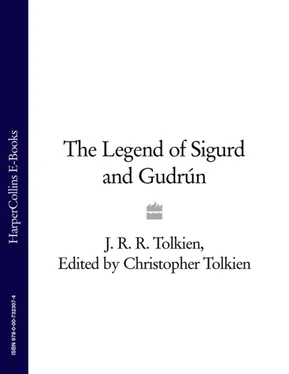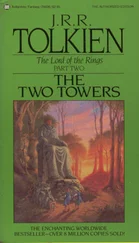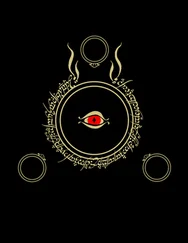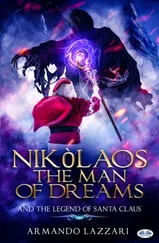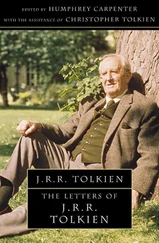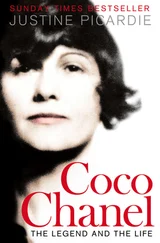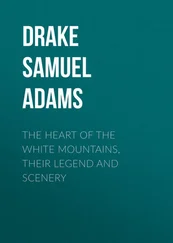J. Tolkien - The Legend of Sigurd and Gudrún
Здесь есть возможность читать онлайн «J. Tolkien - The Legend of Sigurd and Gudrún» — ознакомительный отрывок электронной книги совершенно бесплатно, а после прочтения отрывка купить полную версию. В некоторых случаях можно слушать аудио, скачать через торрент в формате fb2 и присутствует краткое содержание. Жанр: Старинная литература, на английском языке. Описание произведения, (предисловие) а так же отзывы посетителей доступны на портале библиотеки ЛибКат.
- Название:The Legend of Sigurd and Gudrún
- Автор:
- Жанр:
- Год:неизвестен
- ISBN:нет данных
- Рейтинг книги:5 / 5. Голосов: 1
-
Избранное:Добавить в избранное
- Отзывы:
-
Ваша оценка:
- 100
- 1
- 2
- 3
- 4
- 5
The Legend of Sigurd and Gudrún: краткое содержание, описание и аннотация
Предлагаем к чтению аннотацию, описание, краткое содержание или предисловие (зависит от того, что написал сам автор книги «The Legend of Sigurd and Gudrún»). Если вы не нашли необходимую информацию о книге — напишите в комментариях, мы постараемся отыскать её.
The Legend of Sigurd and Gudrún — читать онлайн ознакомительный отрывок
Ниже представлен текст книги, разбитый по страницам. Система сохранения места последней прочитанной страницы, позволяет с удобством читать онлайн бесплатно книгу «The Legend of Sigurd and Gudrún», без необходимости каждый раз заново искать на чём Вы остановились. Поставьте закладку, и сможете в любой момент перейти на страницу, на которой закончили чтение.
Интервал:
Закладка:
From the ‘Poetic Edda’ emerged the adjective Eddaic (and Eddic ), used in contrast to Skaldic (a modern derivative from the Old Norse word skáld meaning ‘poet’). Of Skaldic verse my father wrote in his lecture on the Elder Edda (p.20): ‘It was not until relatively late that “kings” in the North were rich enough or powerful enough to hold splendid court, and when this did come about . . . verse developed its local brief, pithy, strophic, often dramatic form not into epic , but into the astonishing and euphonious but formal elaborations of Skaldic verse.’ This ‘court poetry’, as it may also be called, was an extraordinarily intricate and distinctive art, with extreme elaboration of verse-forms subject to rules of exacting strictness: ‘elaborations’, in my father’s words, ‘in which various kinds of internal and final full-rhyme and half-rhyme both vocalic and consonantal are interwoven with the principles of “weight” and stress and alliteration, with the deliberate object of utilizing to the full the vigour, force and rolling beat of the Norse tongue.’ To which must be added the huge poetic vocabulary, and the extraordinary cultivation (described below) of the device of the ‘kenning’.
‘To us,’ he wrote, ‘thinking of the Elder Edda, “Eddaic” means the simpler, more straightforward language of the heroic and mythological verse, in contrast to the artificial language of the Skalds. And usually this contrast is thought of as one of age as well: old simplicity of good old Germanic days, unhappily given up in a new taste for poetry become an elaborate riddle.
‘But the opposition between “Eddaic” and “Skaldic” verse is quite unreal as one of time, as between older and younger, as of a fine old popular manner being pushed out by a younger, newer fashion. They are related growths, branches on the same tree, essentially connected, even possibly sometimes by the same hands. Skalds can be found to write in fornyrðislag , the oldest of old metres; Skaldic kennings can be found in Eddaic lays.
‘All that remains true of this contrast of age is the fact that the simpler metres, e.g. fornyrðislag and the style that goes with it, are far older, much closer, for instance, to other Germanic things, to Old English verse, than the specially Skaldic verse and manner. The Eddaic poems we have belong to the same period as Skaldic, but the metrical traditions and style they employ carries on still, without fundamental alteration, something of the common Germanic tradition. Old and new in metre rubbed shoulders – it was as we have seen already a transition period, a period of poise between old and new, not maintainable for long [see p.23].’
It is the highly artificial Skaldic poetry that is the subject of Snorri’s instruction in his Edda , and indeed by far the greater part of what survives of it owes its survival to him. In the second part of the book, Skáldskaparmál (‘Poetic Diction’), he treats above all of kennings, with a great number of exemplifying verses by named skalds: but very many of these kennings are wholly incomprehensible without a knowledge of the myths and legends to which they allude – and such themes are not characteristically the subject of the Skaldic poems themselves. In the first part of the Edda (the Gylfaginning ) Snorri drew extensively on Eddaic poetry; and in the Skáldskaparmál also he told the stories on which certain kennings rest. The following is a single example.
Hvernig skal kenna gull? How shall gold be named?
Thus: by calling it the Fire of Ægir; the Pine-needles of Glasir; the Hair of Síf; the Head-band of Fulla; Freyja’s Tears; the Drop, or Rain, or Shower of Draupnir [Ódin’s gold ring, from which dropped other rings]; Otter’s Ransom; Forced Payment of the Æsir; . . .
Following such a list as this, Snorri gave explanations of these locutions.
Hver er sök til þess, at gull er kallat otrgjöld? What is the reason that gold is called Otter’s ransom?
It is told that when the Æsir, Ódin and Loki and Hœnir, went out to explore the world they came to a certain river, and they went along the river to a waterfall; and by the waterfall was an otter . . .
And thus it is that we have the story of Andvari’s Gold told both by the author of the Völsunga Saga and by Snorri Sturluson (see the Commentary on the Lay of the Völsungs, pp.188–91); but indeed Snorri here continued his narrative into a résumé of the whole history of the Völsungs.
It remains to add that the celebrity of Snorri’s book in the centuries that followed, and most especially of the Skáldskaparmál , led, before the emergence of the Codex Regius, to the term Edda being widely used to mean, expressly, the technical rules of the old ‘court’ poetry, or ‘Skaldic’ verse. In those days poets complained of the tyranny of Edda, or offered apologies for their lack of proficiency in the art of Edda . In the words of Gudbrand Vigfússon: ‘An untaught poet who called a spade a spade, instead of describing it by a mythological circumlocution, would be scouted as “Eddaless”’ ( Eddu-lauss , ‘having no Eddaic art’). Thus the term ‘Eddaic’, as now used, in opposition to ‘Skaldic’, is a perfect reversal of its former meaning.
§2 THE SAGA OF THE VÖLSUNGS (
Völsunga Saga
)
The Codex Regius of the Poetic Edda is a collection of poems of great diversity, composed by poets who lived centuries apart; but it was compiled and ordered with intelligent care. Most of the heroic poems are concerned with the story of the Völsungs and the Niflungs; and these the compiler of the collection arranged, so far as the diverse structure and scope of the individual lays allowed him, in a narrative sequence, adding explanatory passages in prose at the beginning and end of many of the lays, and narrative links in the course of them.
But much of the material thus arranged is of the utmost difficulty. Poems are disordered or defective, or even patchworks of different origin altogether, and there are very many obscurities of detail; while worst of all, the fifth gathering of the Codex Regius disappeared long ago (see p.28), with the loss of all Eddaic poetry for the central part of the legend of Sigurd.
In this situation, there is an essential aid to the understanding of the Northern legend. This is the Völsunga Saga , written, probably in Iceland, in the thirteenth century, though the oldest manuscript is much later: a prose tale of the fate of the whole Völsung race from the far ancestry of Sigmund, father of Sigurd, and continuing on to the fall of the Niflungs and the death of Atli (Attila) and beyond. It is founded both on Eddaic lays that survive and other sources now lost; and ‘it is solely from the lays that it has used,’ my father said in a lecture, ‘that it derives its power and the attraction that it has for all those who come to it,’ for he did not hold the author’s artistic capacity in high regard.
This author was faced with wholly divergent traditions (seen in the preserved Eddaic lays) concerning Sigurd and Brynhild: stories that cannot be combined, for they are essentially contradictory. Yet he combined them; and in doing so produced a narrative that is certainly mysterious, but (in its central point) unsatisfying: as it were a puzzle that is presented as completed but in which the looked for design is incomprehensible and at odds with itself.
In the commentary that follows each poem in this book I have noticed many features in which my father departed from the Völsunga Saga narrative, more especially in the case of his Lay of the Völsungs, where the Saga is of much greater importance as a source. He seems not to have set down any critical account of the Saga as a whole, or if he did it has not survived; but comments of his on the author’s work in individual passages will be found in the commentary (see pp.208–11, 221, 244–45).
Читать дальшеИнтервал:
Закладка:
Похожие книги на «The Legend of Sigurd and Gudrún»
Представляем Вашему вниманию похожие книги на «The Legend of Sigurd and Gudrún» списком для выбора. Мы отобрали схожую по названию и смыслу литературу в надежде предоставить читателям больше вариантов отыскать новые, интересные, ещё непрочитанные произведения.
Обсуждение, отзывы о книге «The Legend of Sigurd and Gudrún» и просто собственные мнения читателей. Оставьте ваши комментарии, напишите, что Вы думаете о произведении, его смысле или главных героях. Укажите что конкретно понравилось, а что нет, и почему Вы так считаете.
